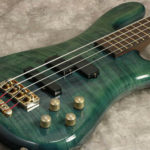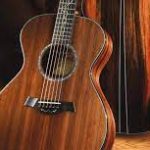fender guitar styles
For as long as they have been around, Fender has never been one to rest on their laurels. They have continued to revamp their guitars for the modern era while staying true to the roots of their illustrious history.
With so many series updates coming and going in Fender’s already impressive selection of instruments, we are truly spoiled for choice. But just how are they different?
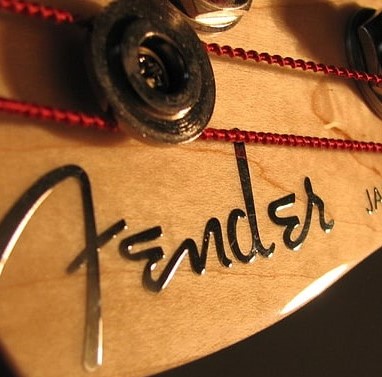
Stratocaster
Fender Stratocaster, is the most iconic guitar of them all. There are plenty of other guitar manufacturers that build Stratocaster-style electric guitars. Apart from selling Strats under their own brand, Fender also manufactures and sells affordable Stratocasters under the Squier name, which is a subsidiary of theirs.
The original Stratocaster was built and launched in 1954 by Leo Fender himself and has gone on to become the very essence of electric guitar, and it’s arguably the coolest-looking guitar of all unless you ask the guitar players who prefer the Les Paul. Since the Les Paul came out before the Stratocaster, Leo Fender and his team worked hard on creating a guitar that was going to go up against Gibson, but with a radically different design. The most distinctive thing about the Strat, apart from the sound, is its body shape.
The original Stratocaster was built and launched in 1954 by Leo Fender himself and has gone on to become the very essence of electric guitar, and it’s arguably the coolest-looking guitar of all unless you ask the guitar players who prefer the Les Paul. Since the Les Paul came out before the Stratocaster, Leo Fender and his team worked hard on creating a guitar that was going to go up against Gibson, but with a radically different design. The most distinctive thing about the Strat, apart from the sound, is its body shape.
The Stratocaster features a double-cutaway design, so that players can access those upper frets using not only their fretting fingers but their thumb as well. The Stratocaster has six inline tuners, and three single-coil pickups. Of course, there are Strats which have both, but we are talking about the default Stratocaster configuration.

The three-pickup setup was designed by Leo Fender not only as a way to distinguish the Stratocaster from its main competitor but also as a way of providing guitar players with a wider selection of tones and sounds. Single coil pickups are known for their brighter, thinner sound, but when combined, they can produce anything from crunchy rhythm tones to smooth, creamy solos, as well as that signature Stratocaster twang that has made this guitar so desirable. Although originally manufactured with a three-way selector switch, modern Strats usually have a five-way switch, which allows for “in-between” sounds.
The Stratocaster is also known for its tremolo bridge, which is a spring-loaded mechanism that allows the player to change the pitch of the note or the entire chord using the tremolo arm, also known as the whammy bar. There are different ways in which you can change the pitch of the note, whether it’s by shaking the bar or simply bending it back and forth. The player which has really taken the use of tremolo to a whole new level is Jeff Beck, which uses it for both dramatic effects and delicate, subtle notes.
the Stratocaster is a pretty versatile guitar, although its tone is usually associated with the blues. And sure, the Strat sounds great when you play it clean or when you use low gain, and because of those clear treble notes, it easily cuts through any kind of mix. However, it is equally brilliant when you want to play loud rock and roll and hard rock with plenty of gain, jazz, funk, pop, country, punk, or rhythm, and blues. In case you want to use it to play metal, you might be better with a Strat which utilizes humbucker pickups, or a Superstrat, which we will get to in the next section of this guide.
Given its legendary status, the Stratocaster has been played by numerous guitar players and virtuosos, including Jeff Beck, Jimi Hendrix, Eric Clapton, Ritchie Blackmore, Rory Gallagher, Stevie Ray Vaughan, David Gilmour, Eric Johnson, Mark Knopfler, Buddy Holly, Robin Trower, Hank Marvin, Buddy Guy, Eric Gales, John Frusciante, and Yngwie Malmsteen, among others.
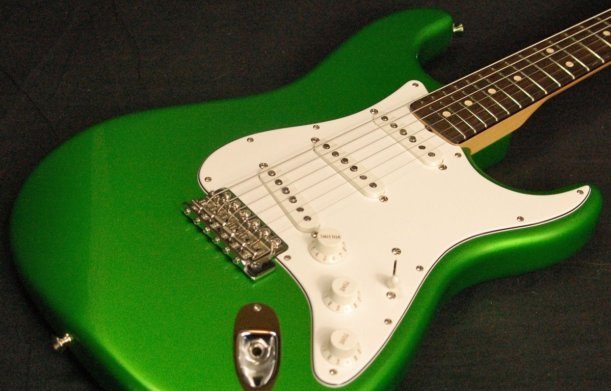
Telecaster
Another iconic guitar by Fender, the Telecaster, or simply Tele, is the first successfully mass-produced electric guitar. It was introduced back in 1951, only a few years before the Strat, and has gone on to become one of the most popular guitars in history. If you are a fan of the famous Stratocaster twang, you will love the Tele even more, since that sound is even more pronounced here. It was the reason why the Telecaster was so popular among country and indie players, before being discovered by blues, funk, and rock crowds. If properly set up, the Telecaster can even be used to produce a more aggressive sound, as well as tones which you wouldn’t expect from a Telecaster, as is evident by Tom Morello’s use of this particular guitar.
Although the Telecaster is hugely popular, it is strange to find that its shape and design haven’t been replicated by a lot of guitar manufacturers, which was the case with the Stratocaster and Les Paul. Apart from cheap copies made by lesser-known companies, Telecaster guitars are predominantly made by Fender and Squier. When it was originally released, the Telecaster was known as the Broadcaster, until Fender got sued, because there was an existing drum kit model called the Broadkaster.
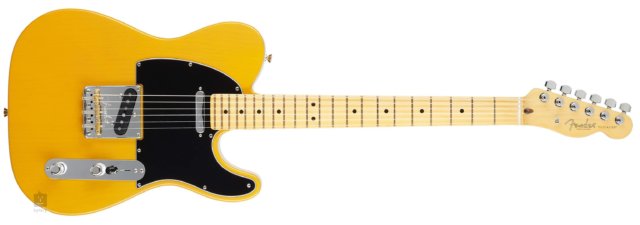
In addition to its vintage look with a single cutaway, the Telecaster also has a few more unique characteristics. Although you can find Telecasters that use humbuckers or Strat-style pickups, they usually have two single-coil pickups and a three-way selector switch. What’s unique to the Telecaster is that the bridge pickup is slightly angled, while the neck single coil pickup has a lipstick cover. Another thing you will also see on most Telecasters is the “ashtray” bridge, which got its name because the players used to remove the metal bridge cover and use it as an ashtray. Instead of a setup that uses six steel saddles, the Tele has three brass saddles, which contribute to the thinner, twangier sound of the guitar.
Unlike the Strat, the body of the Telecaster has almost no contouring, apart from the single cutaway. As in the case of the Stratocaster, different types of tonewoods are used, depending on the price bracket. In nearly all cases, the neck is made from maple and is bolted onto the body. Fretboards are either rosewood or maple. The most notable players which are associated with the Telecaster are Bruce Springsteen, Keith Richards, Roy Buchanan, George Harrison, Jeff Buckley, Tom Morello, Muddy Waters, Prince, Danny Gatton, and Freddie Stone, among others. Telecaster is one of the most common types of electric guitars and you will see it often.
Jaguar
Fender Jaguar first appeared on the market back in 1962. It was promoted as one of Fender’s high-end models. Paradoxically, it became really iconic only thanks to the 1970’s punk rockers who adored Jaguar’s crispy and punchy sound.
Technically, this instrument was really exceptional from the beginning – having more controls than any other Fender guitar at the time, Jaguar boasted the most complex circuit around. It was also the very first Fender electric guitar coming with various neck widths. Thanks to its shorter scale, Fender Jaguar is also commonly preferred by smaller or beginner players who benefit from its convenient playability.
To name just a few, this guitar was also preferred by many iconic musicians like Kurt Cobain, Black Francis, Brian Molko, and John Frusciante.
Fender Jaguar has a standard offset body – it’s basically the same shape and design you can see on Jazzmaster. However, this model has a shorter scale (24 inches/610 mm), which makes it easier to reach all the frets and allows you to play faster.
Like most Fender guitars, Jaguar’s solid body is constructed of alder. This medium-weight wood provides great sustain, beautiful lows, and full-bodied character in general. The neck – designed in modern “C” shape – is made of maple, which adds to the guitar’s bright and dynamic tone.
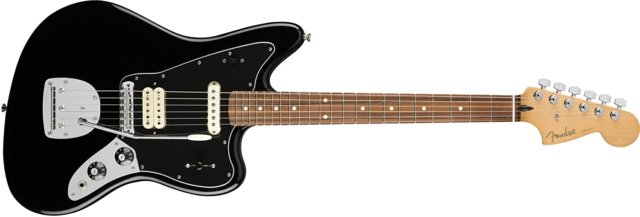
When it comes to Jaguar’s distinctive sound qualities, the crucial factor is the guitar’s shielded pickup that effectively eliminates any undesired electrical hum.
As a result, Jaguar sounds beautifully crisp and punchy. Another unique feature that can help you articulate and sculpt your sound entirely is Jaguar’s bass switch – use it to make your guitar sound almost painfully bright.
Most experienced players would probably agree that Fender Jaguar doesn’t sound like any of the other Fender models. You definitely can’t compare it to Tele or Strat, but it’s also very easy to distinguish Jaguar from Jazzmaster – the closest model. Jaguar is simply one of a kind.
Finally, if you’re after the outer beauty, Fender Jaguar comes in various lovely finishes – mostly classic, although definitely far from boring. If you like a traditional look, you will probably go with iconic Sunburst or sleek Black. If you’d like to be seen from afar, focus on Buttercream, Polar White, or Tidepool finishes.
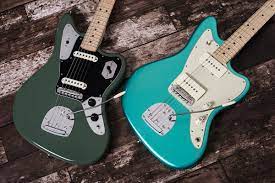
Jazzmaster
The Fender Jazzmaster was first introduced to the public at the 1958 NAMM Show. The model was presented as Stratocaster’s advanced (and more expensive) brother, appealing mostly to jazz guitarists and surf rockers of the early 1960s.
However, as time went by, it became obvious that Jazzmaster’s biggest asset is its versatility. This guitar with stunningly full-bodied and warm sound can be many things to many different kinds of players – from jazzmens to rockers or even medalists.
To name just a few of its proud and famous owners, Jazzmaster is reportedly a weapon of choice for Robert Smith, Elvis Costello, Ric Ocasek, or Sean Lennon. How can you know if Fender Jazzmaster is ideal for you too?
First of all, you have to be at peace with its offset body (typical for Fender Jaguar too), which can be a bit odd for players who are used to more symmetric curves of Stratocaster or Telecaster.
Secondly, you have to fall in love with its mellow sound and rich mids – but that part is really easy.
When it comes to the size and shape of the body, Fender Jazzmaster and Jaguar guitars are extremely similar. The offset waist of its alder body is a characteristic you will notice from afar.
The main difference is that while Jaguar comes with a shorter scale, Fender Jazzmaster has a full-length 25.5-inch scale. This probably makes this model a bit more suitable for players who are already used to Stratocaster, Telecaster, Esquire, or any other Fender guitars with standard scale length.
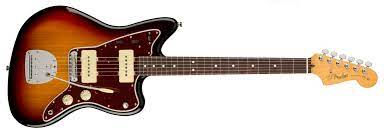
Again, the neck is designed in a modern “C” shape and made of maple. One small difference we haven’t mentioned before – while Jaguar traditionally has metal pickguards, Fender Jazzmaster has a control plate made of plastic.
Unlike Fender Jaguar, Jazzmaster has two humbucker pickups without metal encasing that contribute to the guitars significantly warmer and more rounded sound. Nevertheless, it’s still beautifully punchy or even biting in some positions, so you definitely shouldn’t underestimate it.
One possible downside – some players can’t get used to Jazzmaster’s noisier pickups.
The noise is definitely more present than you might be used to with some other Fender guitars (although some Jazzmaster models are noisier than others too). For some players, this might be a serious dealbreaker. For others it’s probably just something to get used to.
Jazzmaster uses a traditional three-way toggle switch, which feels very familiar, however, it also means that this guitar lacks some of Jaguar’s uniqueness and functions (switch to turn off bass).
Fender Jazzmaster can be viewed as a simpler version of Jaguar. Just like they have identical bodies, they also share the same type of floating tremolo that distinguishes the guitars from many other models.
If you’re unsure which strings are your best choice with this instrument, experienced players recommend balanced medium gauge 11/50s. This provides you with a little tension that complements Jazzmaster much better than any other setup.
Jazzmaster comes in a classic range of finishes that include Sunburst, Black, Polar White, Tidepool, and Buttercream.
Starcaster
Often considered one of the more esoteric novelties in the history of Fender guitars, the Starcaster—with its uniquely offset semi-hollow body and curvaceous, divisive headstock—arrived in 1976 as the company’s first new electric model in three years. It proved unpopular at the time and was discontinued by the fall of 1980, but over the years its unique shape, full-throated tone and rarity in the vintage market helped boost its popularity. In 2013, due to rising demand, Fender reintroduced the Starcaster and put into production the Starcaster bass—the only offset semi-hollow bass guitar in Fender history.
The original Starcaster models featured an arched, laminated maple top with dual f holes and a maple back and sides. It housed two Fender Wide Range humbucker pickups with chrome covers with a three-way toggle switch and five silver-skirted black control knobs: neck pickup volume, neck pickup tone, bridge pickup volume, bridge pickup tone, and master volume.
Whereas you’d have been hard pressed to find Starcasters in many high-profile hands during its original 1970s era—Leo Nocentelli of the Meters is a notable exception—you needn’t look very hard today to see them put to prominent use by several noted guitarists both on stage and in the studio.
Radiohead’s Jonny Greenwood played his Starcaster on acclaimed albums OK Computer (1997), Kid A (2000) and Amnesiac (2001) and has used it extensively onstage for songs including “The Tourist,” “Street Spirit (Fade Out)”, “Optimistic” and “Pyramid Song” (played using a cello bow). Other notable Starcaster fans include Killers guitarist Dave Keuning, Depeche Mode’s Martin Gore, Morrissey guitarist Jesse Tobias, Jamie Cook of the Arctic Monkeys, Death Cab For Cutie’s Chris Walla, Mooney Suzuki guitarist/vocalist Sammy James Jr., and Our Lady Peace guitarist Steve Mazur.
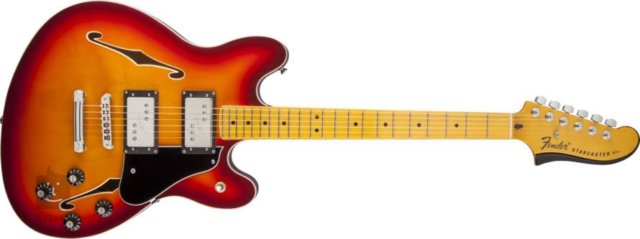
Introduced in 1976, the Starcaster—a rare, semi-hollow addition to the Fender line—failed to excite players at the time and was cut from the price list by the fall of 1980.
And that’s too bad because by most accounts the problem wasn’t that the Starcaster wasn’t a good guitar. On the contrary, those who know the Starcaster generally regard it these days as an instrument that offered solid build, tone and feel. With hindsight, most seem to agree that the Starcaster never caught on for two reasons: unfortunate timing and misguided intent.
The timing was unfortunate in the sense that the mid-to-late 1970s was a troubled period in Fender history. As the decade wore on the company found itself selling more instruments and amps than ever, but quality control problems under the cost-cutting rule of CBS, who purchased the company in 1965, were well evident by this time, and murmurings were beginning to circulate that if you wanted a good Fender guitar or amp, you needed an older one that pre-dated their purchase of the company.
Unusual for a semi-hollow guitar, the Starcaster had an offset waist — a classic Fender design element made famous by earlier solid-body models, most notably the Jazzmaster guitar (1958) and Jazz Bass (1960). This offset double-cutaway body featured front and back binding and a solid maple center block that provided sturdiness and sustain not found in the Coronado models a generation earlier. The Starcaster had an arched laminated maple top with dual f holes and a maple back and sides. It came in several “thick-skin” high-gloss finishes including Blonde, White, Black, Natural, Walnut, Antigua, Wine, and Tobacco Sunburst.
The Starcaster’s bolt-on neck was another Fender hallmark. It was made of hard-rock maple with a “bullet” truss rod adjustment and Micro-Tilt neck adjustment. It also featured an unusual six-on-a-side headstock design with a dark-painted fin-like curve opposite the tuners and below the logo—Fields originally came up with this headstock design for the ill-fated 1966 Marauder. Its 10-inch radius maple fingerboard had 22 nickel-silver medium jumbo frets and black-dot inlays.
Fender had been experimenting with humbucking pickups for several years by the mid 1970s, and the Starcaster featured two Fender Wide Range humbucking pickups with chrome covers and individually adjustable pole pieces. The control setup was fairly elaborate for a Fender guitar and featured a three-way toggle pickup switch on lower horn and five silver-skirted black control knobs: neck pickup volume, neck pickup tone, bridge pickup volume, bridge pickup tone and—unusual for a Fender—a master volume.
Other features included a three-ply black-white-black pickguard, a six-saddle adjustable bridge, Grover Rotomatic tuners, stainless steel flatwound strings and a hardshell case. A handful of prototype Starcaster basses were also made, but these never entered production at the time.
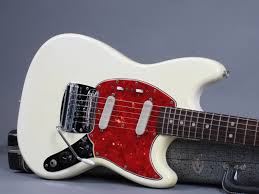
Mustang
As one of the more affordable “genuine vintage Fender guitars” in the ’80s and ’90s, Mustangs were snapped up and hot-rodded by punk, grunge, indie-rock and alt-rock players who were in search of punchier, more powerful sounds than the original, fairly weak single-coil pickups could provide.
The Mustang was unveiled in 1964 at the tail end of Fender’s pre-CBS years in an effort to upgrade the company’s beginner and student lines. Previously, in 1956, Fender unveiled its scaled-down, single-pickup Musicmaster and dual-pickup Duo-Sonic models to capture the business of young players hot for this new rock and roll fad.
These models quickly became gateway guitars to more grown-up Fenders. Each had a 22 1/2–inch scale length that was shorter than anything Fender had yet produced in a Spanish-electric. These short-scale models are sometimes referred to as “three-quarter-scale” guitars, but they’re closer to nine-tenths the size of a standard Fender model from the day.
A slight reworking of the body style and electronics delivered both the hardtail Duo-Sonic II and vibrato-equipped Mustang in ’64, and although both were also still available in the shorter 22 1/2–inch scale length early on, the 24-inch scale quickly became more popular for both models.
The body represented another slight departure for Fender, both in its more compact and streamlined size and shape and in the poplar wood that was most often used for its construction. The neck was the standard bolt-on Fender configuration of one-piece maple with a rosewood fingerboard and generally feels superbly comfortable in the hand.

Both were made in two different widths, too, as measured at the nut and indicated by a letter code found alongside the date stamped on the neck’s heel: “A” indicated a narrower 1 7/16–inch width, while “B” signaled the more standard, and more desirable, 1 5/8 inches.
The Mustang vibrato was an entirely new contraption, with a sprung tailpiece unit and separate rocking bridge, all mounted to the same base plate (with much of the workings hanging underneath).
New, too, were the electronics. The pickups were made similarly to the Stratocaster’s but were entirely covered, with no pole pieces showing, and often tended to be a little weaker.
Each was wired through its own three-way slider switch, which provided not only “on” and “off” positions but also an out-of-phase setting in relation to the other pickup when both were on and the switches set in opposite directions.
Original Mustangs of 1964–’68 vintage were offered in white, blue and red finishes similar to Fender’s Olympic White, Daphne Blue and Dakota Red, although they were never officially named as such.
The Competition Series Mustangs, which featured diagonal racing stripes and forearm and rib cage contours, were introduced in 1968 and fetch about 30 percent more on the vintage market today. This is purely due to their cosmetics, as ’64–’66 Mustangs can be perfectly excellent electric guitars.
The Mustang remained in regular production until 1982, when ownership shake-ups at Fender induced a lot of changes. It was back by demand in reissue form in 1990. For examples in the hands of pros, check out Kurt Cobain’s frequent use of a battered Mustang (often with bridge humbucker added), David Byrne with early Talking Heads or Matthew Healey of the 1975, among many others.
Lead II
Between 1979 and the launch of Fender Japan in 1982, the Leads filled a simple niche at the low end of the company’s all-American six-string range: they were no-frills axes for the post-punk era, combining Stratocaster stylings with the simplicity of the Telecaster. Their legacy is hardly in the same league as either of those guitar giants, of course, but that makes them perfect candidates for the modern Mexican-built Player Series.
Coming in just under the £600 mark, we get the Lead II, which looks uncannily like the 1979 original, right down to the blocky headstock logo and cramped pickup switches, and the Lead III, with the same coil-split-equipped twin-humbucker configuration as its 1982 ancestor.
They may look rather like student guitars, but both models have Fender’s full 25.5-inch scale length and, thanks to the aforementioned switches, some handy tonal options. The extra toggle on the Lead II is a phase-flipper for quacky cancellation in the middle position, while the one on the Lead III can be used to put either pickup (but not both) into single-coil mode.
The basic body shape isn’t likely to alienate longtime Fender fanatics, with a Strat-style double cutaway and a generous belly-carve swooshed out of the back. Alder and maple construction keeps things classic (you get a maple or pau ferro board depending on the finish), and the bridge is functional Fender at its best: a simple hardtail with six solid saddles, three screws holding it in place and the strings running through the body.
In terms of the pickups, we’re in familiar territory once again, at least with the Lead II, whose pickups are both fitted at a dynamic slant and are the same alnico V units you’ll find in the Player Stratocaster. The Lead III’s alnico II humbuckers, meanwhile, are shared with the Player Stratocaster HSS and Jazzmaster. It’s safe to say we’re not expecting these guitars to sound quite as far-out as they look.

The Strat-like qualities suggested by the Lead II’s specifications are very much present and correct. Clean tones are brisk and characterful, with lots of slappy attitude when you dig in on individual notes. There’s certainly no shortage of treble on either pickup, and we soon find ourselves dialling the tone control down to about six or seven for a more balanced response.
There’s a fair amount of phasey complexity on the bridge pickup, but even more in the middle position – a setting that, remember, Fender’s three-pickup icon doesn’t normally support. This is where the Lead II really excels as a Strat-Tele hybrid, combining the breezy freshness of the former with the chiming sweetness of the latter.
Then we flip the phase switch and are greeted by a quack so extreme it feels like being attacked by angry mallards. It’s not clear whether the average player will have any use for a sound as hollowed out as this, but it could be a cool thing to have in the locker nevertheless.
As we make the transition from gaudy green to violent violet, it’s worth mentioning that the toggle switches on both of these guitars are a bit of a pain. They’re very close together and feel stubby and uncertain, and, as we mentioned earlier, the coil-splitter on the Lead III does not include an option for running both pickups in their slimmed-down states together.
Still, there’s not a lot wrong with this instrument in full humbucking mode. Predictably, it’s much darker than the Lead II, and all three positions offer chunky yet articulate tones that work well with a dollop of Marshall-style overdrive for old-school Superstrat lead work.
The clean stuff is nice too but there’s a surprise in store when we activate the coil-split on either pickup: the lower mids thin out as expected but not in a way that leaves the guitar sounding in any way underpowered. The top end actually seems to expand to fill the gap and suddenly the Lead III becomes even more bright and spiky than the Lead II. This could be useful but, as before, you’re likely to be reaching for the tone control to keep things balanced, so make sure you’re ready to whip it up to 10 again when you bring back the second coil.
That’s a decent selection of tones from a solidly built pair of instruments, with a few quirks but no deal-breaking flaws. The only thing missing from this reborn range, in fact, is the Lead I model with its single, splittable, series/parallel-switchable humbucker.
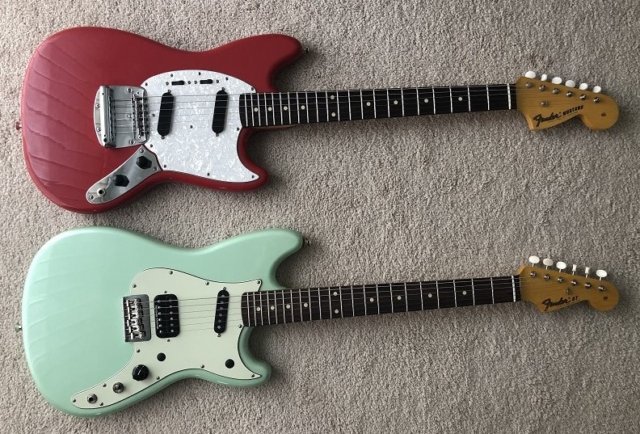
Duo-Sonic
If you’re looking for a compact electric guitar with a great reputation and tons of character, Fender Duo-Sonic HS should definitely be on your radar. This modern remake of a classic vintage guitar originally presented in 1956 offers exceptional playability and superb sound supported by its great pickup configuration. Is it the right guitar for you? Read our Fender Duo-Sonic HS review for all the details.
Original Fender Duo-Sonic presented a simple yet perfectly efficient electric guitar of a ¾ size with two vintage-style single-coil pickups. Originally produced and promoted as a student guitar, Duo-Sonic went on to exceed all the expectations and attracted many professionals including some of the greatest guitarists of all time.
Thanks to its great popularity, the model was reissued in three updated versions and several modern remakes. The Fender Duo-Sonic HS we are focusing on in this review was first released in 2016 as a 24-inch scale remake with a characteristic pickup setup that attracts mostly those who are keen to experiment and broaden their creative horizons.
Stunningly beautiful, incredibly playable, and exceptionally versatile. Those are the three superlatives that immediately come to my mind when I think of Fender’s Duo-Sonic HS.
This guitar might be forever overshadowed by the legendary Stratocaster or Telecaster series, but I truly believe that in some regards, this might be the best choice for many different types of players.
The Fender Duo-Sonic HS is a beautiful, very traditionally looking guitar with a characteristic thin waist of an offset instrument. It’s a solid body guitar that feels incredibly friendly in your hands mainly due to the great shape, perfect size, and smooth satin finish of its C-shaped maple neck.

Fender Duo-Sonic HS dimensions are 42.10 x 15.20 x 4.50 inches, and the guitar weighs 9.78 pounds. This makes it a great choice for anyone who prefers smaller instruments, whether it is a player with smaller hands, a junior player, a female guitarist, or simply someone who likes the freedom to experiment and bend the guitar however he or she wants.
The main differences between classic Fender Duo-Sonic and Fender Duo-Sonic HS are all related to the technical equipment of these guitars. First of all, this newer/modernized version of the model diverts from the traditional single-coil pickups configuration, replacing one of them (the bridge one) with a humbucker that allows coil-tapping for even more possibilities and versatility.
But although this humbucker is definitely the guitar’s biggest star, you shouldn’t underestimate the HS’s single-coil neck pickup either. As we’ll discuss later, it contributes to the guitar’s perfectly balanced sound and tonal qualities just as much as its coil-splitting counterpart.
Fender Duo-Sonic HS guitar also has a characteristic bridge. While the original Duo-Sonics have classic three-saddle bridges, the HS model sports a six-saddle hardtail bridge with through-body stringing.
Body, neck, pickups, bridge, and controls – in the end, it all comes down to the quality of the sound these components can produce together, right? The best thing about the Fender Duo-Sonic HS guitar is that all of these partial elements really do complement each other in the best possible way, which shows off in the form of endless tonal possibilities this instrument offers.
The humbucking pickup provides you with all the grit and rumble you might need, while the fresh and crispy single-coil brings on the typical brightness and clarity we usually adore with Fender guitars.
Each of the controls you have at hand gives you additional options to bend, articulate, adjust, and transform the voice according to your taste or needs. And there’s also an extra 22nd fret for an even wider range of tones and options.
Whether you’re playing with riffs and layers or you’re after some masterful solos, this guitar ignores any limitations and jumps smoothly from one role into the other. This also makes this guitar perfect for pretty much any genre you can imagine – rock, folk, country, you name it.
Guitar & Gear Articles















